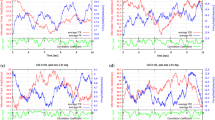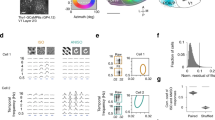Abstract
Neural populations across cortical layers perform different computational tasks. However, it is not known whether information in different layers is encoded using a common neural code or whether it depends on the specific layer. Here we studied the laminar distribution of information in a large-scale computational model of cat primary visual cortex. We analyzed the amount of information about the input stimulus conveyed by the different representations of the cortical responses. In particular, we compared the information encoded in four possible neural codes: (1) the information carried by the firing rate of individual neurons; (2) the information carried by spike patterns within a time window; (3) the rate-and-phase information carried by the firing rate labelled by the phase of the Local Field Potentials (LFP); (4) the pattern-and-phase information carried by the spike patterns tagged with the LFP phase. We found that there is substantially more information in the rate-and-phase code compared with the firing rate alone for low LFP frequency bands (less than 30 Hz). When comparing how information is encoded across layers, we found that the extra information contained in a rate-and-phase code may reach 90 % in Layer 4, while in other layers it reaches only 60 %, compared to the information carried by the firing rate alone. These results suggest that information processing in primary sensory cortices could rely on different coding strategies across different layers.





Similar content being viewed by others
References
Adrian, E. (1928). The basis of sensations. New York: Norton.
Basalyga, G., & Wennekers, T. (2009). Large-scale computational model of cat primary visual cortex. BMC Neuroscience, 10(Suppl 1), p358.
Belitski, A., et al. (2008). Low-frequency local field potentials and spikes in primary visual cortex convey independent visual information. Journal of Neuroscience, 28(22), 5696–5709.
Berens, P., et al. (2008). Comparing the feature selectivity of the gamma-band of the local field potential and the underlying spiking activity in primate visual cortex. Frontiers in Systems Neuroscience, 2(2), 2.
Bialek, W., et al. (1991). Reading a neural code. Science, 252(5014), 1854–1857.
Brette, R., et al. (2007). Simulation of networks of spiking neurons: a review of tools and strategies. Journal of Computational Neuroscience, 23(3), 349–398.
Buzas, P., et al. (2006). Model-based analysis of excitatory lateral connections in the visual cortex. Journal of Comparative Neurology, 499(6), 861–881.
Carnevale, N.T., & Hines, M.L. (2006). The NEURON book. Cambridge, UK: Cambridge University Press.
Cover, T.M., & Thomas, J.A. (1991). Elements of information theory. New York: Wiley.
de Ruyter van Steveninck, R.R., et al. (1997). Reproducibility and variability in neural spike trains. Science, 275(5307), 1805–1808.
DeAngelis, G.C., et al. (1999). Functional micro-organization of primary visual cortex: receptive field analysis of nearby neurons. Journal of Neuroscience, 19(10), 4046–4064.
Destexhe, A., et al. (2001). LTS cells in cerebral cortex and their role in generating spike-and-wave oscillations. Neurocomputing, 38, 555–563.
Destexhe, A., et al. (1996). In vivo, in vitro, and computational analysis of dendritic calcium currents in thalamic reticular neurons. Journal of Neuroscience, 16(1), 169–185.
Destexhe, A., et al. (1998). Dendritic low-threshold calcium currents in thalamic relay cells. Journal of Neuroscience, 18(10), 3574–3588.
Engel, A.K., et al. (1990). Stimulus-dependent neuronal oscillations in cat visual cortex: inter-columnar interaction as determined by cross-correlation analysis. European Journal of Neuroscience, 2(7), 588–606.
Gilbert, C.D. (1977). Laminar differences in receptive field properties of cells in cat primary visual cortex. Journal of Physiology, 268(2), 391–421.
Grossberg, S., & Versace, M. (2008). Spikes, synchrony, and attentive learning by laminar thalamocortical circuits. Brain Research, 1218(4), 278–312.
Haeusler, S., & Maass, W. (2007). A statistical analysis of information processing properties of lamina-specific cortical microcircuit models. Cerebral Cortex, 17(1), 149–162.
Hellwig, B. (2000). A quantitative analysis of the local connectivity between pyramidal neurons in layers 2/3 of the rat visual cortex. Biological Cybernetics, 82(2), 111–121.
Hill, S., & Tononi, G. (2004). Modeling sleep and wakefulness in the thalamocortical system. Journal of Neurophysiology, 93(3), 1671–1698.
Hines, M.L., & Carnevale, N.T. (2008). Translating network models to parallel hardware in NEURON. Journal of Neuroscience Methods, 169(2), 425–455.
Hodgkin, A.L., & Huxley, A.F. (1952). A quantitative description of membrane current and its application to conduction and excitation in nerve. Journal of Physiology, 117(4), 500–544.
Holmgren, C., et al. (2003). Pyramidal cell communication within local networks in layer 2/3 of rat neocortex. Journal of Physiology, 551, 139–153.
Holt, G.R., & Koch, C. (1999). Electrical interactions via the extracellular potential near cell bodies. Journal of Computational Neuroscience, 6(2), 169–184.
Izhikevich, E.M., & Edelman, G.M. (2008). Large-scale model of mammalian thalamocortical systems. Proceedings of the National Academy of Science (USA), 105(9), 3593–3598.
Katzner, S., et al. (2009). Local origin of field potentials in visual cortex. Neuron, 61(1), 35–41.
Kayser, C., et al. (2009). Spike-phase coding boosts and stabilizes information carried by spatial and temporal spike patterns. Neuron, 61(4), 597–608.
Kruse, W., & Eckhorn, R. (1996). Inhibition of sustained gamma oscillations (35–80 Hz) by fast transient responses in cat visual cortex. Proceedings of the National Academy of Sciences, 93(12), 6112–6117.
Lindén, H., et al. (2011). Modeling the spatial reach of the LFP. Neuron, 72(5), 859–872.
Logothetis, N.K., et al. (2007). In vivo measurement of cortical impedance spectrum in monkeys: implications for signal propagation. Neuron, 55(5), 809–23.
Markram, H. (2006). The blue brain project. Nature Reviews Neuroscience, 7(2), 153–160.
Mazzoni, A., et al. (2011). Cortical dynamics during naturalistic sensory stimulations: experiments and models. Journal of Physiology Paris, 105(1–3), 2–15.
Mazzoni, A., et al. (2008). Encoding of naturalistic stimuli by local field potential spectra in networks of excitatory and inhibitory neurons. PLoS Computational Biology, 4(12), e1000239.
Migliore, M., et al. (2006). Parallel network simulations with NEURON. Journal of Computational Neuroscience, 21(1), 119–129.
Miikkulainen, R., et al. (2005). Computational maps in the visual cortex. Berlin, New York: Springer.
Montemurro, M.A., et al. (2007a). Role of precise spike timing in coding of dynamic vibrissa stimuli in somatosensory thalamus. Journal of Neurophysiology, 98(4), 1871–1882.
Montemurro, M.A., et al. (2007b). Tight data-robust bounds to mutual information combining shuffling and model selection techniques. Neural Computation, 19(11), 2913–2957.
Montemurro, M.A., et al. (2008). Phase-of-firing coding of natural visual stimuli in primary visual cortex. Current Biology, 18(5), 375–380.
Nordlie, E., et al. (2009). Towards reproducible descriptions of neuronal network models. PLoS Computational Biology, 5(8), e1000456.
O’Keefe, J., & Recce, M.L. (1993). Phase relationship between hippocampal place units and the EEG theta rhythm. Hippocampus, 3(3), 317–330.
Onat, S., et al. (2011). Natural scene evoked population dynamics across cat primary visual cortex captured with voltage-sensitive dye imaging. Cerebral Cortex, 21(11), 2542–2554.
Panzeri, S., et al. (2007). Correcting for the sampling bias problem in spike train information measures. Journal of Neurophysiology, 98(3), 1064–1072.
Pettersen, K.H., & Einevoll, G.T. (2008). Amplitude variability and extracellular low-pass filtering of neuronal spikes. Biophysical Journal, 94(3), 784–802.
Pospischil, M., et al. (2008). Minimal Hodgkin-Huxley type models for different classes of cortical and thalamic neurons. Biological Cybernetics, 99(4–5), 427–441.
Protopapas, A.D., et al. (1999). Simulating large networks of neurons. In C. Koch, & I. Sefev (Eds.), Methods in neuronal modeling from ions to networks (chapter 12, pp. 461–498). Cambridge, MA: MIT Press.
Rasch, M.J., et al. (2011). Statistical comparison of spike responses to natural stimuli in monkey area V1 with simulated responses of a detailed laminar network model for a patch of V1. Journal of Neurophysiology, 105(2), 757–778.
Salinas, E., & Sejnowski, T.J. (2001). Correlated neuronal activity and the flow of neural information. Nature Review Neuroscience, 2(8), 539–550.
Shadlen, M.N., & Newsome, W.T. (1998). The variable discharge of cortical neurons: implications for connectivity, computation, and information coding. Journal of Neuroscience, 18(10), 3870–3896.
Shannon, C.E. (1948). A mathematical theory of communication. The Bell System Technical Journal, 27, 379–423, 623–656.
Sillito, A.M., & Jones, H.E. (2002). Corticothalamics interactions in the transfer of visual information. Philosophical Transactions of the Royal Society London B, 357(1428), 1739–1752.
Skottun, B.C., et al. (1991). Classifying simple and complex cells on the basis of response modulation. Vision Research, 31(7–8), 1078–1086.
Strong, S.P., et al. (1998). Entropy and information in neural spike trains. Physical Review Letters, 80(1), 197–200.
Szymanski, F.D., et al. (2011). The laminar and temporal structure of stimulus information in the phase of field potentials of auditory cortex. Journal of Neuroscience, 31(44), 15787–15801.
Thomson, A.M., & Lamy, C. (2007). Functional maps of neocortical local circuitry. Frontiers in Neurocsience, 1(1), 19–42.
Tiesinga, P., et al. (2008). Regulation of spike timing in visual cortical circuits. Nature Reviews Neuroscience, 9(2), 97–107.
Traub, R.D., et al. (2005). Single-column thalamocortical network model exhibiting gamma oscillations, sleep spindles, and epileptogenic bursts. Journal of Neurophysiology, 93(4), 2194–2232.
Traub, R.D., & Miles, R. (1991). Neuronal networks of the hippocampus. Cambridge, UK: Cambridge University Press.
Tsodyks, M., et al. (1998). Neural networks with dynamic synapses. Neural Computation, 10(4), 821–835.
Tsodyks, M., et al. (2000). Synchrony generation in recurrent networks with frequency-dependent synapses. Journal of Neuroscience, 20(1), 1–5.
Ursino, M., & Cara, G.E.L. (2006). Travelling waves and EEG patterns during epileptic seizure: analysis with an integrate-and-fire neural network. Journal of Theoretical Biology, 242(1), 171–187.
Wohrer, A., & Kornprobst, P. (2009). Virtual retina: a biological retina model and simulator, with contrast gain control. Journal of Computational Neuroscience, 26(2), 219–249.
Xing, D., et al. (2009). Spatial spread of the local field potential and its laminar variation in visual cortex. Journal of Neuroscience, 29(37), 11540–11549.
Acknowledgement
This work was supported by EPSRC research grant EP/C010841/1.
Author information
Authors and Affiliations
Corresponding author
Additional information
Action Editor: Gaute T Einevoll
Rights and permissions
About this article
Cite this article
Basalyga, G., Montemurro, M.A. & Wennekers, T. Information coding in a laminar computational model of cat primary visual cortex. J Comput Neurosci 34, 273–283 (2013). https://doi.org/10.1007/s10827-012-0420-x
Received:
Revised:
Accepted:
Published:
Issue Date:
DOI: https://doi.org/10.1007/s10827-012-0420-x




